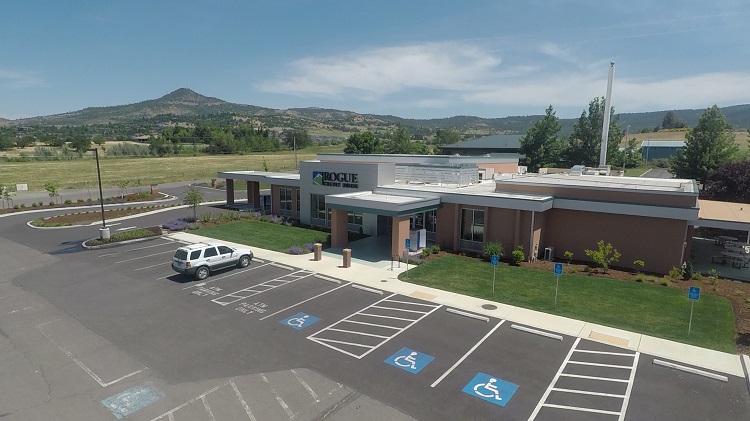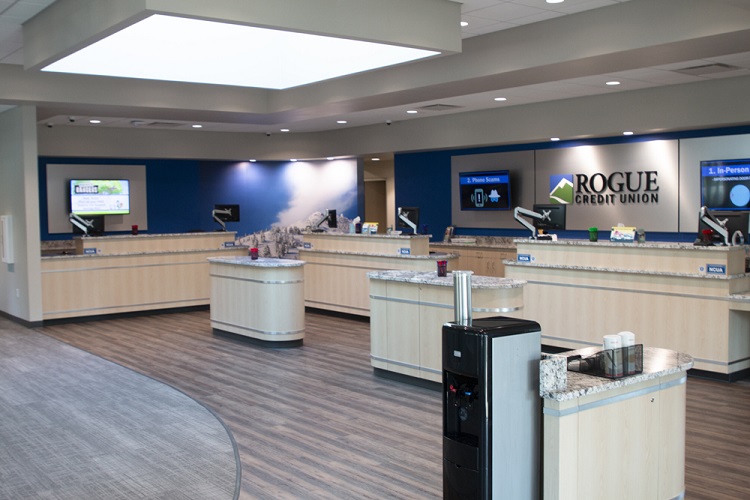Top-Level Takeaways
-
Rogue Credit Union emphasizes measures of member loyalty over growth for growth’s sake.
-
Branch network expansion is accommodating double-digit member growth while branch design blends current service models with future delivery.
Rogue Credit Union ($1.5B, Medford, OR) is building out a branch network that gives members what they want now while making way for new ways of doing business.
CU QUICK FACTS
Rogue Credit Union
Data as of 06.30.18
HQ: Medford, OR
ASSETS: $1.5B
MEMBERS: 128,702
BRANCHES: 20
12-MO SHARE GROWTH: 10.1%
12-MO LOAN GROWTH: 14.1%
ROA: 1.36%
In the past few years, the Beaver State cooperative has added four branches to existing markets and placed two more in new ones. It has also remodeled two other branches, has two more under construction, and plans for another two.
A year or two ago I would have said we were an anomaly, that maybe there was something about our southern Oregon demographics that is different from the rest of the industry, says Matt Stephenson, the credit union’s executive vice president. But now we’re seeing otherwise.
ContentMiddleAd
So is the rest of the banking industry. American Banker recently reported that JPMorgan Chase and Bank of America plans to open as many as 900 new branches between them in the next few years. According to the Wall Street Journal, more than 1,200 banks, most of them small, have actually expanded their branch networks since 2012.
But the overall trend remains: Financial institutions are closing branches. According to Callahan’s BranchAnalyzer, credit unions and banks closed 1,646 and 5,295 branches, respectively, in the 12 months ending on June 30, 2017. So, what’s going on at Rogue?

Rogue Credit Union’s East Medford Branch is an integral part of an expanding branch network that EVP Matt Stephenson says is ridiculously busy.
The $1.5 billion credit union is opening and revamping branches as part of a growth strategy that’s not necessarily a growth strategy at all.
It’s a loyalty strategy, Stephenson says. None of our goals are based on growth for growth’s sake.
To that end, Rogue leadership values measurements that encapsulate loyalty, such as Net Promoter Score and assessments for ease of use, turnaround times, and brand awareness.
Hard numbers indicate the credit union’s strategy is working. For example, Rogue served 6,416 members per branch as for the first quarter of 2018. That’s up from 4,856 five years ago. Rogue’s total membership has grown 12.36% in the past four years. By comparison, membership at credit unions with $1 billion to $10 billion in assets has grown 5.73% in the same period.
Rogue Credit Union has not reported a quarterly member growth rate of less than 10% year-over-year since the second quarter of 2014.
Stephenson says 90% of its member growth is coming from existing markets, and 79% is at existing branches.
We haven’t had a quarter with member growth of less than 10% in quite some time, Stephenson says. That has a lot to do with how we’re serving our markets. We are clearly benefiting from competitors who are forcing their customers toward delivery channels they want instead of the ones their customers want.
Giving members what they want shows in the credit union’s new branch designs. The designs feature interactive teller machines outside, which provide a versatile transition from the traditional tubes. Pods inside have replaced traditional teller windows, although Rogue is still using the pods to serve traditional teller lines.

Rogue’s branch design emphasizes traditional service with the capacity to accommodate new self-service and consultative methods as member demand changes.
We have too much traffic in our branches and our members aren’t ready to change our way of doing business, Stephenson says. But when they are, we’ll be ready.
3 Guiding Principles
Growth at Rogue Credit Union is the result of a strategy based on loyalty, says Matt Stephenson, executive vice president at the Oregon cooperative. According to Stephenson, Rogue uses these three points guide its branching strategy:
- Don’t focus on growth for growth’s sake.
- Create flexible branch designs that can evolve with member needs.
- Don’t force members toward technology for which they’re not ready.
The credit union also has expanded its Saturday branch hours from a 2 p.m. closing to 5 p.m. closing. The result has been a 54% increase in Saturday transactions, 57% increase in loans, and 61% increase in account openings.
The ITMs also enabled the credit union to efficiently expand to 7 a.m. to 7 p.m. service hours. Approximately 75% of that usage is ATM transactions, but the ability to talk to a person when needed is crucial.
Make sense of deposit data for individual branches, institutions, and entire markets. With BranchAnalyzer, the ability to make smart tweaks to your branching strategy is just a click away. Learn more.
According to Stephenson, 60% of surveyed members say they prefer the interactive teller machines to walking into a branch. But if a member makes the effort to walk into a branch to talk with someone, Rogue wants to be there for that.
Still, Stephenson is quick to note that the credit union’s digital channels are its fastest growing, by far.
We’re not putting all our eggs in one basket, the Rogue EVP says, adding that the credit union recently updated its website and will go live with a new internet banking platform in January.
We’re not na’ve, Stephenson says. The rest of the world sees something coming and has this knee-jerk reaction. We see it coming, too, but we’re not going to disenfranchise members right now because of something we see 10 years down the road.

